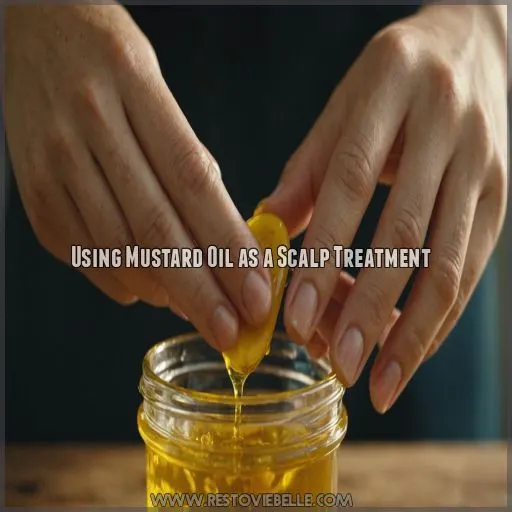This site is supported by our readers. We may earn a commission, at no cost to you, if you purchase through links.
 You’re in for a real treat – mustard oil can work wonders for your hair!
You’re in for a real treat – mustard oil can work wonders for your hair!
This marvel of nature is packed with nourishing fatty acids, vitamins, and antioxidants that’ll give your locks a newfound shine and strength.
Simply massage a few drops into your scalp and let it work its magic.
The antibacterial and anti-inflammatory properties can even soothe pesky dandruff and eczema.
But don’t jump in headfirst – always do a patch test first, as mustard oil can be irritating for some.
Once you get the green light, get ready to say goodbye to dull, lifeless hair and hello to a healthy, vibrant mane.
Your tresses are about to level up!
Table Of Contents
- Key Takeaways
- What is Mustard Oil?
- Mustard Oil’s Benefits for Hair
- Potential Risks and Precautions
- How to Make a Mustard Oil Hair Mask
- Using Mustard Oil as a Scalp Treatment
- Mustard Oil as a Quick Pre-Shampoo Treatment
- Patch Testing and Consulting a Doctor
- Frequently Asked Questions (FAQs)
- Is mustard oil good for your hair?
- How long should you keep mustard oil in your hair?
- Does mustard oil darken hair?
- Can we leave mustard oil on hair overnight?
- How often should I use mustard oil on my hair?
- Can mustard oil be used on colored or dyed hair?
- How long should I leave mustard oil in my hair?
- Is mustard oil safe for use on children?
- What are the best ways to store mustard oil?
- Conclusion
Key Takeaways
- mustard oil is a hair care powerhouse – it nourishes your locks with fatty acids, vitamins, and antioxidants for a healthy, vibrant mane. However, be cautious, as it can irritate sensitive skin, so it’s important to choose a shaving cream for sensitive skin.
- Whip up a DIY mustard oil hair mask with almond and jojoba oils for an at-home spa treatment that will leave your hair silky-smooth. Massage it in from roots to ends, then rinse for a little self-care boost.
- Use mustard oil as a pre-shampoo treatment to tame frizz, protect against heat damage, and prep your hair for a more effective cleanse. Just apply a small amount to the ends, let it soak in for 10 minutes, then shampoo as usual.
- When trying mustard oil, always do a patch test first to check for any sensitivities. Also, steer clear of using it on babies and young children – their delicate skin may not be able to handle the potent properties.
What is Mustard Oil?
Mustard oil is a versatile ingredient with roots in Indian and Nepalese cuisine.
Derived from the seeds of the mustard plant, this oil has garnered attention for its potential hair care benefits, much like the benefits of walnut oil.
Mustard Oil Extraction and Usage
Mustard oil is extracted from the seeds of the mustard plant, yielding a versatile oil with a distinct pungent aroma.
Historically, it has been a staple in Indian and Nepalese cuisines, but its uses extend beyond the kitchen.
While the FDA restricts its use in the US due to erucic acid content, mustard oil offers an array of potential hair benefits when used cautiously. This is similar to how the FDA regulates fish oil.
Mustard Oil in Indian and Nepalese Cuisine
A staple in Indian and Nepalese kitchens, mustard oil adds a bold, pungent flavor to beloved dishes.
This versatile oil is revered for its culinary traditions, enriching curries, dals, and marinades with its distinctive taste.
Whether drizzled over roasted vegetables or used for sautéing, mustard oil infuses meals with a delightful zing, making it an indispensable ingredient in these vibrant cuisines.
Erucic Acid Content and FDA Restrictions in the US
Why isn’t mustard oil approved for consumption in the US?
The reason lies in its erucic acid content, which raises red flags with the FDA. Concerned about potential health risks, they’ve restricted its use.
Though global regulations may differ, the FDA’s stance on mustard oil is clear. If you’re wary of erucic acid, exploring alternative oils could be wise.
Mustard oil boasts a vibrant culinary heritage across India and Nepal, but its restricted use in the US is a significant consideration for those looking to incorporate it into their cooking.
Types of Mustard Plants Used for Oil Extraction
The mustard plant comes in black, brown, and white varieties – each offering slightly different properties for your hair.
Whether you prefer a lighter or more robust oil, the type of mustard plant used in extraction can really impact the benefits and experience.
Experiment to find which works best for your unique hair needs.
Mustard Oil’s Benefits for Hair
Discover the surprising hair-enhancing benefits of mustard oil. From soothing scalp conditions to fighting off dandruff, this versatile oil can work wonders for your tresses.
Conditioning Properties and Rich Fatty Acid Composition
You’ll be amazed by mustard oil’s conditioning abilities.
Its rich fatty acid profile – packed with nourishing monounsaturated, polyunsaturated, and saturated fats – helps moisturize and add luster to lackluster locks.
Think of it as an indulgent deep conditioning treatment that leaves your hair soft, supple and shimmering with health.
Soothing Scalp Conditions Like Dermatitis, Eczema and Psoriasis
Mustard oil’s warming nature may soothe irritated scalps prone to dermatitis, eczema, and psoriasis.
Its anti-inflammatory properties can alleviate redness, flakiness, and itchiness.
Gently massaging a small amount of mustard oil into the scalp may offer natural relief for these stubborn skin conditions. Just be sure to do a patch test first to check for sensitivity.
Antibacterial and Antifungal Effects for Dandruff and Scalp Acne
Does dandruff or scalp acne have you feeling down?
Mustard oil’s antibacterial and antifungal properties may be your new best friend. It can help restore balance to your scalp microbiome.
Gently eliminating pesky dandruff and calming irritation can be achieved by massaging a bit of mustard oil into your roots – your scalp will thank you!
Potential Risks and Precautions
While mustard oil can work wonders for your hair, it’s essential to use caution when using it.
Certain skin types may experience irritation or even develop a condition called lichen planus.
To use mustard oil safely, be sure to thoroughly rinse the oil to avoid clogging pores. Additionally, avoid using it on babies and young children.
Skin and Eye Irritation
Sensitive skin types may find mustard oil a bit too intense. Its warming compounds like allyl thiocyanate can cause redness, stinging, or irritation, especially around the eyes.
To minimize potential issues, it’s essential to take precautions when using mustard oil. Always do a patch test before applying the oil to your hair or scalp to check for any adverse reactions.
Thoroughly rinse the oil after application to avoid lingering irritation.
Lichen Planus Skin Rash
Unfortunately, for some, mustard oil may trigger an unpleasant skin condition known as lichen planus.
Symptoms and Precautions
A rash marked by purple lesions or white blisters may appear. If this rash appears, discontinue use immediately and consult a dermatologist.
Safe Use and Precautions
With the right precautions, you can safely enjoy mustard oil’s hair benefits without irritation, just like with vitamin E oil.
Clogged Pores and Importance of Thorough Rinsing
Mustard oil can clog pores if not rinsed thoroughly.
A thorough rinse helps your hair stay healthy, strong and bouncy, without any oily residue.
After applying, make sure to wash it out completely to avoid leaving behind residue that could weigh down your hair or cause buildup on the scalp.
Caution With Use on Babies and Young Children
If you’re thinking about using mustard oil on little ones, tread carefully. Your baby’s delicate skin may not take kindly to its potent properties. Stick to gentler alternatives like vitamin E or vitamin B-rich oils. And if you spot any irritation, redness, or discomfort, halt use and consult a doctor right away. Their health and comfort come first.
- Avoid using mustard oil on babies and young children
- Opt for milder, nourishing oils like vitamin E or B
- Monitor for signs of skin irritation or reactions
- Discontinue use and seek medical advice if any issues arise
- Your child’s wellbeing is the top priority
How to Make a Mustard Oil Hair Mask
Revitalize your locks with a homemade mustard oil hair mask like grapeseed oil.
Simply combine mustard oil with nourishing almond and jojoba oils.
Then apply the warm mixture from roots to ends and let it soak in for 30 minutes before rinsing.
Combining Mustard Oil With Almond and Jojoba Oils
Crafting the perfect mustard oil hair mask is a cinch!
Mix 1 tablespoon each of mustard, almond, and jojoba oils – it’s a nourishing trio that’ll have your locks glowing.
Warm the blend slightly before generously applying from roots to ends.
This moisture-rich elixir works wonders on dry, damaged hair.
| Oil | Benefits |
|---|---|
| Mustard | Conditions and strengthens hair |
| Almond | Deeply moisturizes and softens |
| Jojoba | Mimics natural sebum, fighting frizz |
Applying the Mask From Roots to Ends
Start by applying the warm, aromatic hair mask from your roots all the way down to the ends.
Massage it gently into your scalp to stimulate circulation and nourish the follicles.
This helps the precious mustard oil and blend of carrier oils penetrate deeply for maximum benefits, a process similar to how olive oil can penetrate hair.
Leaving It on for 30 Minutes Before Rinsing
Let the mask work its magic! Leave the nourishing blend on your hair for a rejuvenating 30 minutes. This allows the oils to deeply penetrate, replenishing moisture and shine. Rinse thoroughly afterward – no harsh scrubbing needed. Your strands will feel softer, smoother, and more manageable. Enjoy the spa-like experience!
- Relaxing 30-minute treatment
- Deep oil absorption for intense hydration
- Gentle rinse for no irritation
Using Mustard Oil as a Scalp Treatment
Gently massaging a small amount of mustard oil directly into your scalp can work wonders for your hair health.
Start by diluting the oil with a carrier like coconut or jojoba to avoid irritation.
A good ratio is 1 part mustard oil to 2 parts carrier oil.
Massage the mixture into your scalp using circular motions, focusing on any dry or flaky areas.
Leave it on for up to an hour before rinsing thoroughly.
Scalp Massage Techniques Dilution Ratio Frequency of Use
mustard oil : 2 parts carrier oil
This simple scalp treatment can help soothe inflammation, nourish the roots, and promote healthy hair growth.
Just be mindful of any sensitivity and discontinue use if irritation occurs.
With some experimentation, you’ll find the right mustard oil routine for your luscious locks.
Mustard Oil as a Quick Pre-Shampoo Treatment
Want to give your hair a quick pick-me-up before you shampoo?
Try this simple trick:
Apply a small amount of mustard oil to your hair, focusing on the ends.
Leave it on for 10 minutes before shampooing as usual.
Your locks will thank you for the extra nourishment!
Applying Oil to the Hair, Focusing on the Ends
Apply a pea-sized amount of mustard oil to the ends of your hair, focusing on those pesky split ends.
This quick pre-shampoo treatment helps smooth down frizz, tame flyaways, and protect your locks from heat damage.
Massage the oil in gently for a luxurious at-home spa experience.
Leaving It on for 10 Minutes Before Shampooing
After applying the mustard oil to your hair, focusing mainly on the ends, let it work its magic for about 10 minutes.
This quick pre-shampoo treatment allows the nourishing oils to deeply penetrate and:
- Boost hair’s moisture levels
- Smooth frizzy strands
- Enhance shine and softness
- Protect against heat damage
- Prepare hair for a more effective cleansing
Patch Testing and Consulting a Doctor
Before using mustard oil, it’s essential to perform a simple patch test to safeguard your scalp and strands. A little prevention can go a long way in avoiding any potential issues.
To conduct the patch test, apply a small amount of the oil to the inside of your forearm and wait 24-48 hours. This will help you determine if you have any sensitivity to the oil.
| Patch Test Spot | Time Frame | Reaction |
|---|---|---|
| Inner Forearm | 24-48 Hours | No Irritation |
| Redness, Itching, Irritation |
If the patch test goes well, you can proceed with using the oil. However, if you experience any worrying reactions, such as redness, itching, or irritation, it’s wise to consult your dermatologist before incorporating mustard oil into your hair routine.
They can provide personalized guidance on using this potent botanical safely and effectively.
Frequently Asked Questions (FAQs)
Is mustard oil good for your hair?
You bet, mustard oil can work wonders for your mane!
It’s loaded with nourishing fats that moisturize and strengthen hair.
Just don’t overdo it – a little goes a long way in taming frizz and promoting healthy growth.
How long should you keep mustard oil in your hair?
Leave mustard oil on your hair for 30 minutes to an hour.
Thoroughly rinse it off.
This allows the nourishing fats and antioxidants to deeply condition and moisturize your locks without over-oiling your scalp.
Does mustard oil darken hair?
Ah, so you’re curious about mustard oil’s hair darkening powers, eh?
Well, let me spill the beans – it’s a bit of a mixed bag.
Get ready for a wild ride!
Can we leave mustard oil on hair overnight?
Leaving mustard oil on overnight can work, but it’s not ideal.
The potent aroma may linger, and prolonged contact risks skin irritation.
For best results, limit applications to 30 minutes or less, then rinse thoroughly.
How often should I use mustard oil on my hair?
Mustard oil is a hair hero that works its magic best when you let it shine 1-2 times a week.
Any more and you risk a grease-slick situation, so play it cool, partner.
Can mustard oil be used on colored or dyed hair?
You can use mustard oil on colored or dyed hair, but be gentle.
It may strip color over time, so do a patch test first and limit applications.
Listen to your hair’s needs – it’ll let you know if it’s too much!
How long should I leave mustard oil in my hair?
It’s best to leave mustard oil on your hair for 30 minutes to an hour.
This will allow it to deeply nourish and condition your locks.
Don’t forget to rinse it out thoroughly afterward!
Is mustard oil safe for use on children?
Mustard oil might not be the best choice for young kids.
Their delicate skin might react poorly.
Always patch test first.
If you decide to use it, proceed with caution and keep a close eye on your child.
Safety should always come before anything else.
What are the best ways to store mustard oil?
Store mustard oil in an airtight container away from light and heat.
Refrigeration can extend its shelf life.
Be sure to allow it to come to room temperature before use for the best consistency and flavor.
Conclusion
Imagine your hair as a wilting flower, yearning for nourishment.
Mustard oil is the gentle rain that revives its vibrant beauty.
This versatile elixir nourishes from roots to ends, soothing scalp concerns and imparting a healthy, lustrous shine.
Embrace the power of mustard oil and achieve the hair of your dreams – soft, strong, and simply stunning.
A few drops is all it takes to transform your tresses and your confidence.
Mustard oil, your hair’s new best friend.













